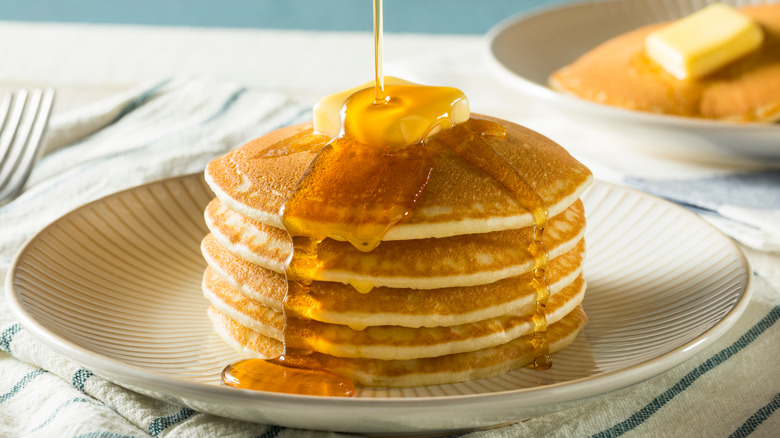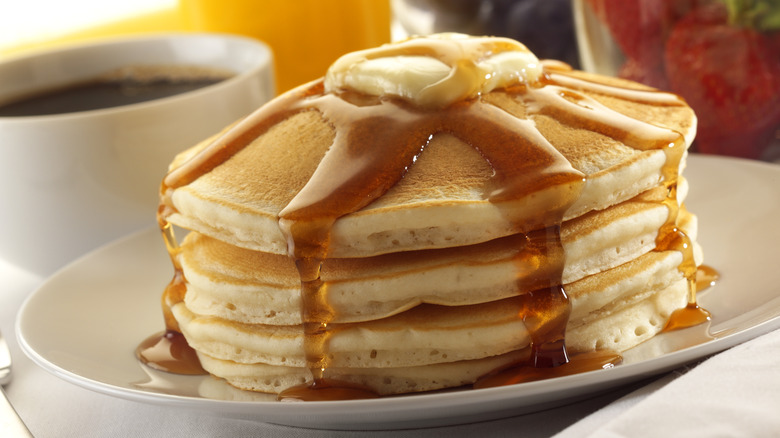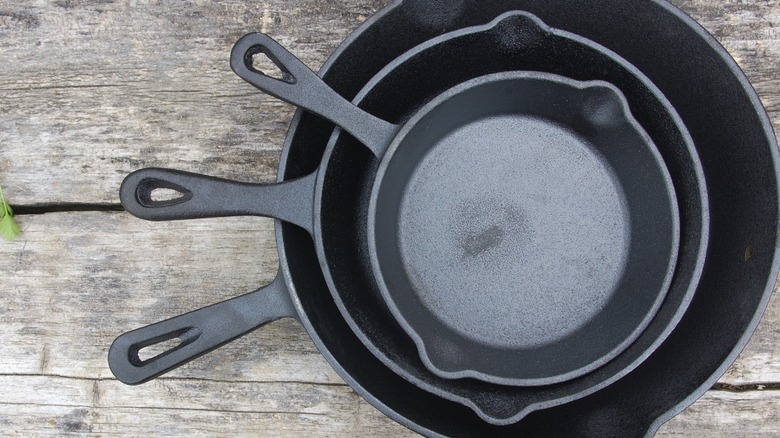A Cast Iron Skillet Is Key To Upping Your Pancake Game
Nothing comes close to completing a weekend morning like a nice stack of light and fluffy pancakes. From-scratch pancake batter only requires a few ingredients, and it can be cooked up in a flash. The only problem is how exactly to cook it. There are as many vessels for preparing flapjacks as there are varieties of pancakes themselves. For consistently great results, however, reach for your cast iron cookware.
Cast iron offers a number of advantages for this cooking task. Most crucially, it is extremely good at retaining heat. Once it has been preheated, a cast iron pan will feature an even level of warmth throughout its surface, and it will maintain this heat over a long period of time. That means that there won't be any hot spots that will scorch your pancake, something that can happen with other types of pans. A well-seasoned cast iron skillet will also feature a nearly-nonstick coating that allows you to flip pancakes with ease.
It's important to preheat your cast iron before using it, however. Unlike stainless steel cookware, it needs more time to come up to temperature. Simply put your pan on a burner set to medium-low while you mix your pancake batter, and it should be nice and hot by the time you're finished.
Techniques for cooking pancakes in cast iron cookware
Cooking pancakes in butter can lead to delicious, rich results that using oil just can't match. The only problem is that butter has a low smoke point, and is liable to burn while your pancakes are cooking in a cast iron skillet. You might get one good pancake, but the next one can come out worse for wear. The solution to this is simple: Turn to clarified butter.
Clarified butter has had its water and milk solids removed. You may also know it as ghee, a common cooking fat in Indian cuisine. The milk solids are what cause butter to burn when cooked, so removing them gives clarified butter a much higher smoke point. The upshot is that you can cook pancakes in it, and you'll get buttery results without anything burning. You can make your own ghee, or purchase it online or from a grocery store.
Also, when making pancakes, flip them just once. Flipping them multiple times will deflate the airy texture, making them tougher and less appetizing. After you pour the batter into the skillet, wait until small bubbles start to appear at the top of the pancake. This means that the bottom side has been cooked. Flip it over, and let the other side cook for another minute before completely sliding it out of the pan.
Seasoning and maintaining your cast iron pans
All of this is only possible if you take proper care of your cast iron cookware. This can seem like a daunting task, but it's actually fairly simple. There's a common myth that you should never wash a cast iron pan with soap. In reality, soap and hot water is fine. Just make sure you don't scrub for too long or leave it submerged in water for more than a few minutes, as this can cause the surface to rust. Similarly, never run cast iron — or almost any other pan — in the dishwasher.
After cleaning your cast iron cookware, you need to season the pan before putting it away. Seasoning is what gives it that slick, nearly nonstick surface. This is as simple as drizzling a small amount of neutral oil (think canola or grapeseed) into the pan, and rubbing it into the cooking surface. Make sure to only add a teaspoon of oil or less. Using any excess can cause your cast iron pan to become sticky. After you've cooked with it enough times, you may find that this seasoning process isn't even necessary. Just continue using it, and you'll have an incredibly durable pan on your hands.



